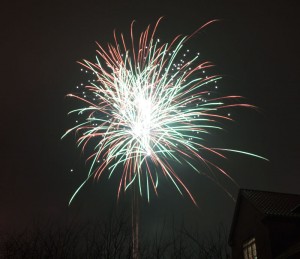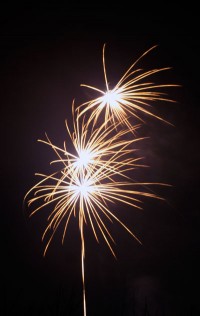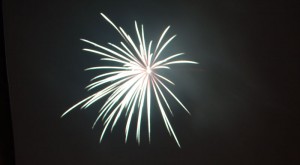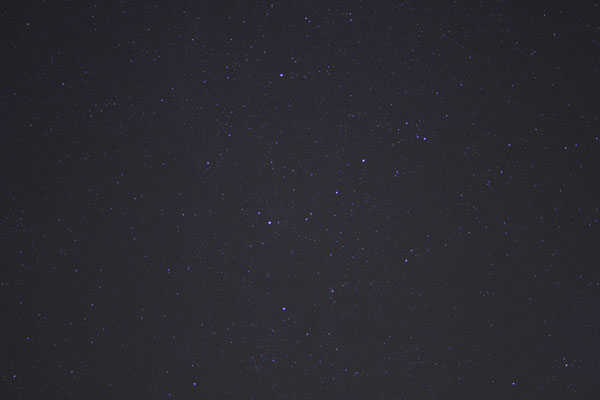The dark twilight-free nights have returned and I thought I would celebrate by trying to photograph the Andromeda Galaxy. It is the most distant object visible with the naked eye, and as I could barely see it from my parents’ backyard, I was wondering if my puny 18-55mm lens could do the job at all. But no try, no gain, right?
It almost took me a full hour to get everything set up. I am getting more routined but it is still a lot of work to set up the equatorial mount, find the north star in the scope, attach the wires, mount the camera, find the target and focus. At least I did not have to backtrack.
I programmed the camera to take 5 exposures of 3 minutes each, but halfway into the second exposure I realized I had forgotten to stop the aperture all the way down. I adjusted the settings but then had trouble focusing: The stars were missing. It turned out that my lens was covered in dew. I wiped it clean, focused and took a trial exposure, but the lens quickly dewed up again. The lens was so cold that the water vapor in the surrounding air condensed on it. So, as I have no heater for the lens, I took it back inside and sat with it under my shirt for half an hour to warm it up.
 When I came back outside the Moon had come up and was lightening up the sky about 40° south of the Andromeda Galaxy. Sigh. Well, I took my 5 exoposures of 3 minutes each (55mm, f/5.6, ISO 800) and the lens stayed dew free. Back inside I got a first good look at the image and lo and behold – there was the Andromeda Galaxy! Sure, it was small and faint, but it was there no doubt.
When I came back outside the Moon had come up and was lightening up the sky about 40° south of the Andromeda Galaxy. Sigh. Well, I took my 5 exoposures of 3 minutes each (55mm, f/5.6, ISO 800) and the lens stayed dew free. Back inside I got a first good look at the image and lo and behold – there was the Andromeda Galaxy! Sure, it was small and faint, but it was there no doubt.
I was a little disappointed to see that my mount had not tracked the stars perfectly. For a single exposure there was no problem, but I could see movement from frame to frame. Luckily it was nothing DeepSkyStacker could not handle. I tuned the levels to make the galaxy stand out as much as possible, and you can clearly distinguish the luminous core. Interestingly enough, it seems my CCD is most sensitive in the middle. Or maybe it has something to do with the lens? Anyway, may I present: The Andromeda Galaxy!
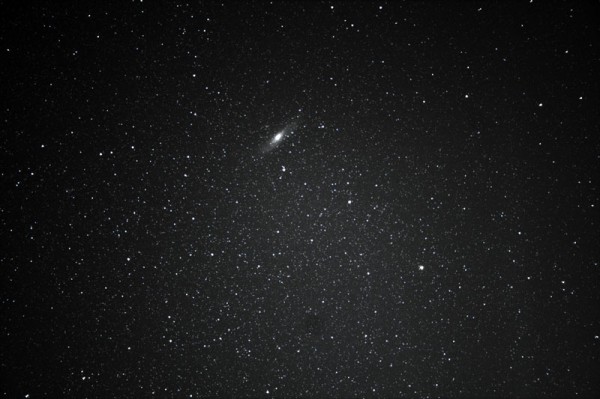
 I did some tests shots last night, and I am really amazed at how good the photos turned out. Of course, there are five years of development between the Canon 550D and my old Canon 350D. Looking through my photos I noticed something interesting. The brightest star trails had a blue line on one side and a red line on the other side: Chromatic aberration! Sure, it is not a desirable effect, but it was actually kind of cool to see something I have learned about in class. :)
I did some tests shots last night, and I am really amazed at how good the photos turned out. Of course, there are five years of development between the Canon 550D and my old Canon 350D. Looking through my photos I noticed something interesting. The brightest star trails had a blue line on one side and a red line on the other side: Chromatic aberration! Sure, it is not a desirable effect, but it was actually kind of cool to see something I have learned about in class. :) I used my standard 18-55mm lens at 18mm. I took a series of 20 second exposures at f/3.5 and ISO 1600. Zooming in on the non-clouded meteor I discovered something cool: The first half of it is green. Apparently this is because the meteor contains magnesium, which shines in blue-green when ignited.
I used my standard 18-55mm lens at 18mm. I took a series of 20 second exposures at f/3.5 and ISO 1600. Zooming in on the non-clouded meteor I discovered something cool: The first half of it is green. Apparently this is because the meteor contains magnesium, which shines in blue-green when ignited. When I came back outside the Moon had come up and was lightening up the sky about 40° south of the Andromeda Galaxy. Sigh. Well, I took my 5 exoposures of 3 minutes each (55mm, f/5.6, ISO 800) and the lens stayed dew free. Back inside I got a first good look at the image and lo and behold – there was the Andromeda Galaxy! Sure, it was small and faint, but it was there no doubt.
When I came back outside the Moon had come up and was lightening up the sky about 40° south of the Andromeda Galaxy. Sigh. Well, I took my 5 exoposures of 3 minutes each (55mm, f/5.6, ISO 800) and the lens stayed dew free. Back inside I got a first good look at the image and lo and behold – there was the Andromeda Galaxy! Sure, it was small and faint, but it was there no doubt.
